Chapter 23.722
STANDARDS FOR PEDESTRIAN-ORIENTED SPACES
Sections:
23.722.030 Pedestrian plan required.
23.722.040 Standards for all pedestrian-oriented spaces.
23.722.050 Standards for on-site pedestrian pathways.
23.722.060 Standards for public spaces.
23.722.010 Purpose.
This chapter establishes provisions for the design and construction of all pedestrian-oriented spaces in Rancho Cordova, including on-site pedestrian pathways and public spaces. The purpose of these standards is to provide for pedestrian-oriented spaces that are safe, comfortable, and usable, provide aesthetic value to the project’s site design, and fully comply with the requirements of the Americans with Disabilities Act and the city-adopted building code. [Ord. 4-2017 § 3 (Exh. B); Ord. 12-2011 § 3 (Exh. A); Ord. 27-2008 § 1 (Exh. A § 4.8.010)].
23.722.020 Applicability.
Whenever a nonresidential, mixed-use, or multifamily residential project is subject to design review, the requirements of this chapter shall apply. [Ord. 4-2017 § 3 (Exh. B); Ord. 12-2011 § 3 (Exh. A); Ord. 27-2008 § 1 (Exh. A § 4.8.030). Formerly 23.722.030].
23.722.030 Pedestrian plan required.
As part of the design review application, the applicant shall submit a pedestrian plan demonstrating compliance with the relevant standards and performance criteria in this chapter. [Ord. 4-2017 § 3 (Exh. B); Ord. 12-2011 § 3 (Exh. A); Ord. 27-2008 § 1 (Exh. A § 4.8.040). Formerly 23.722.040].
23.722.040 Standards for all pedestrian-oriented spaces.
A. Materials. Materials used in pedestrian-oriented spaces shall be attractive, durable, slip-resistant, of high quality, and compatible in color and pattern with a project’s design. Surfaces in pedestrian circulation areas shall be constructed from materials that provide a hard, stable surface and that permit comfortable maneuverability for people of all abilities. Wherever a pathway crosses a drive aisle, loading area, or parking area, the pathway shall be made identifiable by the use of one of the following: elevation changes, changes in paving materials, and/or the use of colors. Such designations are subject to the approval of the council.
B. Lighting. Lighting in pedestrian-oriented spaces shall be consistent with the requirements of Chapter 23.725 RCMC (Outdoor Lighting).
C. Landscaping. Landscaping in pedestrian-oriented spaces shall be consistent with the requirements of Chapter 23.716 RCMC (Landscaping).
D. Electrical Power. To provide adequate power for temporary uses and to ensure proper maintenance, at least two outlets shall be provided for every 2,000 square feet of pedestrian-oriented space.
E. Required Amenities. The following amenities shall be located within all public spaces. Each amenity includes the city-recommended performance standard to ensure the successful design of public space.
1. Seating.
a. Seating should provide a variety of abundant, accessible, comfortable seating options throughout pedestrian-oriented spaces. Specific considerations include:
i. Provide a variety of seating types and configurations.
ii. Accommodate solitary and social activities.
iii. Provide a safe, comfortable seating surface with smooth, even surfaces and curved edges.
iv. Seating types shall conform to crime prevention standards, such as “open seating” that inhibits vandalism and skateboarding. Armrests or other obstructions shall be provided on any public bench that is designed for two or more people to inhibit the ability to sleep on benches.
b. Seating within public spaces should be provided at the ratio of approximately one linear foot per 30 square feet of space.
c. Seating along pedestrian pathways should be provided at the ratio of approximately one linear foot per two linear feet of pathway.
d. The following kinds of seating may be used to meet the requirement: moveable seating, fixed individual seating, fixed benches with and without backs, and seating designed into architectural features (e.g., walls, planter ledges, and seating steps). All spaces shall include at least two kinds of seating. It is recommended that spaces in excess of 5,000 square feet provide at least three kinds of seating and spaces larger than 10,000 square feet include moveable seating as one of the seating types.
e. Seating that faces a wall shall be located at least six feet away from the wall.
f. Seating as part of a tenant space shall not count toward meeting this requirement.
2. Bicycle Racks. Bicycle racks shall be provided based on the development’s anticipated parking demand (see Chapter 23.719 RCMC (Parking and Loading)). Racks shall be located adjacent to or near bicycle pathways and routes and building entrances.
3. Drinking Fountains. It is recommended that one drinking fountain be provided for every 10,000 square feet of pedestrian-oriented space.
4. Trash Receptacles. It is recommended that one trash receptacle be provided for every 1,500 square feet of cafe space up to 6,000 square feet and spaces in excess of 6,000 square feet include an additional receptacle for every 2,000 square feet of space. Spaces that include an outdoor cafe should provide an additional trash receptacle for every 1,500 feet of cafe space. Trash receptacles shall have a capacity of at least 25 gallons and feature top and/or side openings of at least 12 inches. The city recommends that receptacles be located within 50 feet of all seating areas.
F. Additional Amenities. In addition to the required amenities, the following improvements will further enhance public spaces and should be considered in the design of the spaces, particularly those that are greater than 5,000 square feet in size:
1. Amphitheater.
2. Children’s play area. Play equipment shall be designed and constructed to meet the United States Consumer Product Safety Commission standards and best practices, including the installation of protective surfaces and barriers. To allow for the supervision of children, barriers surrounding the play area shall be substantially transparent and not exceed three feet six inches in height.
3. Directional/directory maps.
4. Game tables and associated seating.
5. Food service. Food shall be served from restaurants located in retail spaces adjacent to a space, kiosks, or open space cafes.
6. Moveable tables and chairs. See subsection (E)(1) of this section for requirements.
7. Public art. Public art shall integrate with the project and the space’s design. Art shall not impede public access, circulation, or visual openness within the space or between the space and adjacent public areas.
8. Stage.
9. Transit station.
10. Water features. Water features may include fountains, reflecting pools, and waterfalls. [Ord. 4-2017 § 3 (Exh. B); Ord. 13-2013 § 4 (Exh. B); Ord. 12-2011 § 3 (Exh. A); Ord. 27-2008 § 1 (Exh. A § 4.8.050). Formerly 23.722.050].
23.722.050 Standards for on-site pedestrian pathways.
A. On-Site Connectivity. The pedestrian paths system shall be designed to provide the pedestrian safe passage throughout the project area. Adherence to all of the following provisions will create maximum safe connectivity for pedestrians:
1. A continuous path which connects the primary entrances of the structure(s) on the site.
2. Clear and continuous paths from every primary building entrance to all transit stops and crosswalks directly adjoining the site.
3. A clear and continuous path that connects the main pedestrian access point to the site with the main entrance of the primary use structure on site.
4. Pedestrian pathways from the building to adjacent streets at a ratio of one for each vehicle entrance on site. For example, if there are two driveways into the site, two sidewalk entries that connect to the building’s primary entrance are required. Entrances designed primarily for service and delivery vehicles are not included in this ratio.
5. Drive aisles leading to main entrances with a walking path on at least one side.
B. Connectivity to Adjoining Property. The pedestrian paths system shall be designed to provide the pedestrian safe passage between adjoining properties and shall connect their pedestrian pathways. Adherence to all of the following provisions will create maximum safe connectivity for pedestrians:
1. A clear and continuous path along all adjacent streets that connects the main entrance of the primary use structure on each property.
2. A clear and continuous path along all drive aisles providing access between the properties that connects the main entrance of the primary use structure on each property.
3. Special pedestrian paths/connections between adjoining lots where those uses are compatible.
C. Building Perimeter Pathways. The following dimensional standards shall apply to building perimeter pathways in nonresidential districts:
1. Building perimeter pathways that are a minimum six feet in width.
2. A continuous building perimeter path interconnecting all entrances and exits of a building.
3. If a parking area is proposed along the building facade within 15 feet from a building wall, a building perimeter path must be provided along the full length of the row of parking spaces facing the building.
D. Site Barriers. Where a berm, landscaping, fencing, or another physical barrier creates a site frontage impenetrable to pedestrians and bicyclists, there shall be no less than one point of access to a pedestrian pathway for every 100 feet of street frontage.
E. Parking Areas. The design and construction of pedestrian pathways into and through parking areas shall comply with the following standards:
1. No parking space shall be located farther than 130 feet from a designated pedestrian pathway.
2. Where parking areas are located between a public right-of-way and a primary entrance into a site’s primary use structure, a continuous and well-designated pedestrian path shall be provided through the parking area that connects the public right-of-way and the said entrance.
F. Standards for Enhanced Pedestrian Pathways. The following minimum standards apply when the enhanced pathway is used:
1. Arcades. If an arcade is provided, it shall be designed and constructed according to the following standards:
Figure 23.722-1: Design Requirements
for Arcades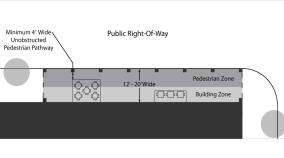
a. Permitted. An arcade may be designed and constructed in conjunction with a commercial or mixed-use project.
b. Width. The width of an arcade shall extend from a building’s facade to the public right-of-way, the edge of an adjacent public space, or the face of the curb along a private street. The minimum width shall be 12 feet and the maximum width shall be 20 feet. The width shall be divided between two zones, the building zone and the pedestrian zone, in the following manner:
i. The pedestrian zone includes the area adjacent to a public right-of-way, adjacent public space, or face of curb and shall be at minimum eight feet wide. This zone shall be free of all obstructions, except for select amenities, including cafe seating and food service vendors, which extend into the zone from the building zone. In the instance of such obstructions, a continuous four-foot-wide unobstructed pedestrian pathway must be maintained throughout the zone.
ii. The building zone is located between the pedestrian zone and a building’s facade and shall be at maximum 12 feet wide. The zone shall include all required amenities (see RCMC 23.722.040(E)) and may include the following additional amenities: cafe seating, directional/directory maps, food service vendors, and public art (see RCMC 23.722.040(F)).
c. Addressing the Street Frontage and Public Space. Arcades shall be designed to address adjoining street frontages and public spaces in the following ways:
i. When a lot occupies the entire street frontage between two intersections, an arcade shall extend along the lot’s entire frontage or provide unobstructed pedestrian flow along the entire frontage in combination with one or more of the following spaces: a corner arcade, a paseo, a plaza, or an intersecting sidewalk widening.
ii. When a lot occupies less than the entire street frontage between two intersections, an arcade shall contribute to unobstructed pedestrian flow along the entire frontage by aligning with one or more of the following spaces on the lot and adjoining lots: a corner arcade, a paseo, a plaza, or an intersecting sidewalk widening.
iii. An arcade adjacent to a public space shall provide continuous unobstructed pedestrian access to the space, except for structural members, and to one or more of the following public spaces that may be located at one or both ends of the arcade: a corner arcade, a paseo, an intersecting extension of the public space, or an intersecting sidewalk widening.
2. Sidewalks along On-Site Main Streets. On-site main streets shall be designed and constructed according to the following standards:
Figure 23.722-2: Design Requirements for Sidewalks along On-Site Main Streets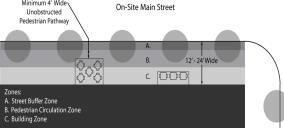
a. Permitted. A sidewalk may be designed and constructed in conjunction with a commercial or mixed-use project.
b. Width. The width of a sidewalk shall extend from the face of the curb backwards toward a building’s facade. The minimum width shall be 12 feet and the maximum width shall be 24 feet. The width shall be divided between three zones – the street buffer zone, the building zone, and the pedestrian circulation zone – in the following manner:
i. The street buffer zone includes the area adjacent to the back edge of a sidewalk. To accommodate the planting of street trees and the placements of tree wells, the zone shall be at minimum four feet wide and at maximum eight feet wide. The zone shall include all required amenities (see RCMC 23.722.040(E)) and may include the following additional amenities: cafe seating, directional/directory maps, food service vendors, and public art (see RCMC 23.722.040(F)).
ii. The building zone includes the area adjacent to a building’s facade and shall be at minimum two feet wide and at maximum 12 feet wide. The zone shall include all required amenities (see RCMC 23.722.040(E)) and may include the following additional amenities: cafe seating, directional/directory maps, food service vendors, and public art (see RCMC 23.722.040(F)).
iii. The pedestrian circulation zone is located between the street buffer zone and the building zone, and shall be at minimum six feet wide. This zone shall be free of all obstructions, except for select amenities, including cafe seating and food service vendors, which extend into the zone from the building zone. In the instance of such obstructions, a continuous four-foot-wide unobstructed pedestrian pathway must be maintained throughout the zone.
3. Paseos. Paseos shall be designed and constructed according to the following standards:
Figure 23.722-3: Design Requirements for Paseos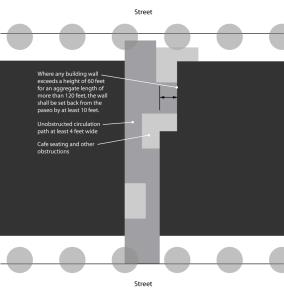
a. Permitted. A paseo may be designed and constructed in conjunction with a commercial or mixed-use project.
b. Width. A paseo shall be at least 20 feet in width.
c. Circulation. A paseo shall contain an unobstructed circulation path at least four feet in width, connecting the two streets on which the paseo fronts.
d. Relationship to Buildings. Where any building wall(s) adjoins a paseo and where such wall(s) exceeds a height of 60 feet for an aggregate length of more than 120 feet, the wall(s) shall be set back from the paseo by a minimum distance of 10 feet. [Ord. 4-2017 § 3 (Exh. B); Ord. 12-2011 § 3 (Exh. A); Ord. 27-2008 § 1 (Exh. A § 4.8.060). Formerly 23.722.060].
23.722.060 Standards for public spaces.
A. Outdoor Gathering Places. Every project shall include one or more outdoor gathering place(s). The size and scale of such areas shall be appropriate to the type and use of each particular development. Appropriate spaces may include building entries, employee break areas, courtyards, pocket parks, plazas, squares, and pedestrian pathways.
B. Public Space Area Requirement. Public space shall occupy at minimum five percent of the gross square footage of new development. All public spaces, including the specific spaces listed in this chapter (arcades, sidewalks adjacent to an on-site main street, and paseos) may count toward meeting this requirement.
C. Sidewalk Frontage. To facilitate access from a public right-of-way or an on-site sidewalk to a public space, the following standards shall be followed:
1. For a public space located adjacent to one street, the area of the space within 15 feet of a public right-of-way or an on-site sidewalk along at least 50 percent of the space’s street frontage shall be free of obstructions, except for those listed below.
2. For corner public spaces, the area within 15 feet of the intersection of two or more streets on which the space fronts shall be at the same elevation as the adjoining sidewalk. In addition, at least 50 percent of each of the space’s frontages shall be free of obstructions, except for those listed below.
3. To be considered free of obstructions, public spaces shall include at least four feet of unobstructed area between obstructions when measured parallel to right-of-way or sidewalk.
4. For obstructed portions of a space’s frontage, no walls or other obstructions, except for those listed in subsection (C)(5) of this section and fixed and moveable seating and tables, shall be higher than two feet above the curb level in front of the space.
5. Trees planted flush to grade, light stanchions, public space signage, trash receptacles, railings for steps, and substantially open fencing around seating areas not exceeding 36 inches in height shall be considered permitted obstructions.
D. Circulation Space. Public spaces shall include one or more unobstructed circulation spaces, connecting all adjacent public rights-of-way, on-site sidewalks, building entrances, and public spaces. These spaces shall be at minimum eight feet wide.
Public spaces shall include one or more unobstructed, continuous circulation spaces of at minimum four feet in width to provide pedestrian access across the spaces and between all adjoining public rights-of-way, on-site sidewalks, primary building entrances, and public spaces.
E. Level of Public Space. To ensure visual surveillance of a public space from the sidewalk and street, the elevation of a public space shall in no location be greater than the average curb level elevation of the nearest adjoining street.
F. Hours of Access. All public spaces shall be accessible to the public at all times, unless the approval authority authorizes a nighttime closing contingent upon the following provisions:
1. A new space may be granted nighttime closing if potentially significant safety issues are documented and submitted as part of an application to authorize the closing.
2. An existing space may be granted nighttime closing if the space has been open for at least one year and significant operational and safety issues have been documented.
3. Nighttime closing of the space is necessary for public safety and/or maintenance within the space.
4. Any approved design element that limits nighttime public access shall not impede public circulation and visual or physical access within the space or between the space and public areas during hours of public operation.
G. Standards for Specific Public Spaces. Building entry spaces, employee break areas, paseos, and plazas shall be designed and constructed to comply with the following standards:
1. Plazas. Plazas shall be designed and constructed according to the following standards:
Figure 23.722-4: Design Requirements for Plazas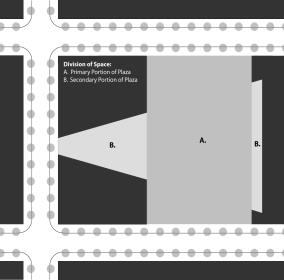
a. Permitted. A plaza may be designed and constructed in conjunction with a commercial, mixed-use, or multifamily residential project.
b. Area. It is recommended that a plaza occupy at least 2,000 square feet.
c. Division of Space. It is recommended that plazas be divided into primary and secondary portions in the following manner:
i. Primary Portion of Plaza. The major portion of a plaza is the largest area of the public plaza and the area of primary use. Major portions should be generally regular in shape, easily and directly accessible from adjoining buildings, public spaces, and public rights-of-way, and continuously visible from within all portions of the public plaza and from adjoining public spaces. Major portions should occupy no less than 75 percent of the total public plaza area.
ii. Secondary Portion of a Plaza. Minor portions of plazas are secondary areas that allow for additional flexibility in the shape and configuration of a plaza. Minor portions should not occupy more than 25 percent of the total area of the plaza.
2. Building Entry Spaces. Building entry spaces shall be designed and constructed according to the following standards:
Figure 23.722-5: Design Requirements for Building Entry Spaces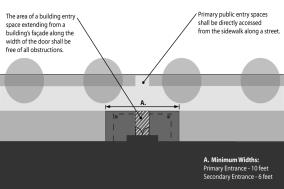
a. Location. A building entry space shall be located adjacent to a building entrance and between the building’s facade and a public right-of-way, a public space, or a sidewalk along a private street.
b. Area. It is recommended that a building entry space occupy at minimum 200 square feet.
c. Width. A primary public entry space shall be at least 10 feet in width and a secondary public entry space shall be at least six feet in width.
d. Access. Primary public entry spaces shall be directly accessed from the sidewalk along a street rather than from a parking lot. Buildings facing public spaces shall have their primary entrances facing the public space. Public access to commercial and governmental buildings shall be provided at sidewalk grade. The primary floor of, and access to, residential structures may be elevated. Secondary access may be provided from off-street parking areas.
e. Obstructions. The area of a building entry space extending from a building’s facade to a sidewalk or public space along the width of the door shall be free of all obstructions.
f. Paving Requirement. A building entry shall consist of at minimum 50 percent decorative paving.
3. Employee Break Areas. Employee break areas shall be designed according to the following standards:
a. Required. Employee break areas shall be included in all projects featuring commercial office or industrial uses.
b. Area. It is recommended that an employee break area occupy at least 200 square feet.
c. Location. An employee break area shall be located adjacent to a pathway connecting the space to a secondary entrance or within a highly visible interior space (e.g., atrium). When an employee break area is located outside of a building, the space shall be separated from parking areas by a walkway, landscaping, a fence, and/or a similar element.
d. Visibility. When an employee break area is located outside of a building, the space shall be visible from at least one public right-of-way. [Ord. 4-2017 § 3 (Exh. B); Ord. 12-2011 § 3 (Exh. A); Ord. 27-2008 § 1 (Exh. A § 4.8.070). Formerly 23.722.070].


